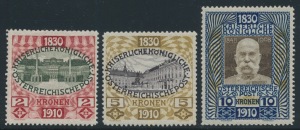Early Bi-colored stamps are among the most popular in philately. Several of the essays for the first postage stamp (the Penny black) were for bi-colored stamps but they were rejected as too expensive to produce and too hard to print with the speed and quality that was necessary for production runs that were as large as postage stamp runs needed to be. Postage stamps are essentially small scale bearer bonds or pieces of currency. Anyone who had one was entitled to the value of the service that it represented. The earliest objections to issuing stamps centered around counterfeiting and cleaning and re-usage of stamps. Because of this concern, early stamps were engraved, which was the printing process of two centuries ago that was hardest to reproduce illegally. Intaglio (engraving ) printing presses were expensive and the creation of stamp dies was artisan’s work. The raised ink on the stamps from engraved printing meant that even casual stamp users could know if they were handling the genuine article.
Engraving meant that the additional expense of bi-colored stamps was not necessary from a security standpoint, and for the first seventy years it was largely souvenir stamps that were printed in more than one color. The birthday set of the Austrian Emperor (above) is such a set. The high values of this set were among the first European bi-colored stamps and evidence that even then these stamps were largely meant for collectors is found from the fact that used examples of these stamps are considerably scarcer, and more valuable, than mint examples. Indeed, multicolored stamps did not really become pervasive until after WWII when engraving gave way to various cheaper methods of printing which allowed easier use of more than one color. This was a technological change in printing efficiency. And, increasingly, the lower price in “real” value of a mint first class postage stamp in wealthier post WWII society meant that anti-counterfeiting measures ceased to be a concern for most major postal agencies.


